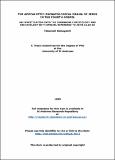The apocalyptic-eschatological drama of Jesus in the Fourth Gospel : an investigation into the Johannine Christology and eschatology with special reference to John 12.20-36
Abstract
In this thesis we will explore the question of Jesus' revelation as a central motif of the Johannine Christology from the perspectives of literary criticism, Jewish apocalypticism and Graeco-Roman dramatic literature. In particular, we will attempt to solve the riddle of the visions developed in John 12.20-36, by answering the fragmentary theory
of the text, the claim for the divergent christologies, the question of realised eschatology with or without future eschatology, and the claim that the Johannine community its
symbolic world creates is 'sectarian'. A special attention will be paid to the Son of man
as presented in the pericope under discussion as well as in the Fourth Gospel as a
whole. The thesis will be summarised as follows:
1. Over against the fragment theory, the concentric arrangement of Jesus' saying
formed predominantly in parallelism shows a deliberate literary design of the author.
Set at the end of the earthly ministry of Jesus, John 12.20-36 is a culminating point of
the revelatory process of Jesus.
2. The overall conceptual framework to understand John 12.20-36, and thus the
Fourth Gospel as a whole, is the apocalyptic idea of the divine mysteries concerning the
.end time. The revelation is centred on Jesus the Son of man, identified as the human-like figure of Dan 7, which culminates in his cross as his glorification/lifting-up. The
vision of the revealed mysteries in Jesus on the cross embraces the eschatological Messiah, the restoration of Israel and of the Temple, salvation, the vindication of the
righteous and the condemnation of the evil, and the Gentiles' pilgrimage, which is
comparable to contemporary Jewish apocalyptic writings.
3. The cross of Jesus as the focus of the apocalyptic vision of the end time lies
behind the apparently divergent christologies (the Son of man, the Davidic Messiah,
divine Wisdom), which are integrated in the text in such a manner that it is impossible
for each to be understood in isolation. The combination of these is already found in the
Jewish apocalyptic-eschatological hope. The fact that the lifting-up and glorification of
the Son of man is given precedence to the Davidic Kingly Messiah deprives a political
and military aspect of the popular Jewish expectation.
4. At the same time, the revelatory pattern of the Johannine Jesus is not only
explicable in Jewish apocalyptic terms, but it has to be understand in view of the anagnorisis, a popular Graeco-Roman dramatic convention. Within the main plot of the
Fourth Gospel Jesus is depicted as the divine homecoming hero-king, as in Homer's
Odyssey, whose messianic identity is closed to many and disclosed to those who
receive him with faith (and hospitality). This pattern is relevant for most of the Johannine Son of man sayings as well. In this plot development John 12.20-36 is situated in
a climactic place where the Jewish crowd fails to recognise Jesus who points to the
decisive moment of his revelation on the cross.
5. The Johannine Eschatology is Jesus centred, and its realised aspect is strongly
emphasised, because the eschatological terminology is overwhelmingly applied to him.
Thus Jesus on the cross is the embodiment of the eschaton. At the same time, the post-Easter period, the time of the church, is open toward its future culmination because of
the mission perspective.
6. The revelation of Jesus as the core of the divine mysteries concerning the end-time centres on the cross, which is presented as both the judgement and the salvation of
the world. The Johannine understanding of the cross is expressed within the framework
of the vindication/exaltation of the suffering righteous. It is implied that Jesus' death
and resurrection inaugurates the new, eschatological covenant for the new people of
God embracing both Jews and Gentiles.
7. John 12.20-36 envisages an apocalyptic vision of the end-time judgement and
salvation, in which the new covenant people is created as a new people of God. The
basis of the new 'children of the Light' is no longer the Law as in the old covenant but
the faith in Jesus the Light (and to love each other as a new law). This faith is not individualistic but geared towards community building, which includes the believers from
the Gentiles. The community itself is the result of the cross of Jesus. The purpose of
Jesus' death for 'bearing much fruit' and gathering of 'all' (nations) to his own house
is to be accomplished in the community through its mission to the world, despite the
probable persecutions.
Type
Thesis, PhD Doctor of Philosophy
Collections
Items in the St Andrews Research Repository are protected by copyright, with all rights reserved, unless otherwise indicated.

